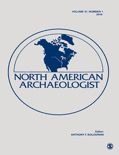
NORTH AMERICAN ARCHAEOLOGIST
Scope & Guideline
Innovating Archaeological Perspectives in North America
Introduction
Aims and Scopes
- Interdisciplinary Approaches:
The journal emphasizes the integration of various disciplines such as anthropology, history, and environmental science to provide a holistic view of archaeological findings. - Indigenous Perspectives:
A significant focus is placed on incorporating Indigenous knowledge and perspectives, particularly in studies related to colonization, cultural heritage, and decolonization efforts. - Technological Innovations:
The journal frequently publishes research that utilizes advanced technologies such as machine learning, geochemical analysis, and acoustic archaeology to analyze artifacts and sites. - Regional Archaeology:
There is a strong emphasis on the archaeology of specific regions within North America, including detailed studies of settlement patterns, subsistence strategies, and social networks. - Environmental and Climate Considerations:
Research addressing the impact of environmental changes, such as climate shifts and natural disasters, on past human societies is a recurring theme. - Material Culture Studies:
The examination of artifacts, particularly lithic tools and pottery, is a core area, with studies focusing on production, use, and cultural significance.
Trending and Emerging
- Climate Change and Archaeology:
Research addressing the implications of climate change on archaeological sites and the historical context of human adaptation to environmental shifts has gained prominence, reflecting a growing concern for sustainability and heritage preservation. - Decolonization and Indigenous Rights:
An increasing number of articles focus on collaborative approaches to archaeology that prioritize Indigenous voices and decolonization, underscoring the importance of ethical practices in archaeological research. - Technological Integration in Archaeology:
The use of cutting-edge technologies, such as machine learning and portable X-ray fluorescence, is becoming more common, showcasing a trend towards innovative methodologies that enhance data analysis and interpretation. - Social Networks and Community Interactions:
There is a growing interest in understanding social dynamics and community interactions in archaeological contexts, particularly in studies that explore feasting practices and social structures. - Environmental Archaeology:
The examination of the relationship between humans and their environments, including studies of subsistence strategies and ecological impacts, is increasingly prominent, indicating a trend towards holistic understandings of past societies.
Declining or Waning
- Traditional Historical Archaeology:
Research focused solely on historical archaeology without a broader interdisciplinary context seems to be declining, as authors increasingly incorporate Indigenous and environmental perspectives. - General Overviews of Archaeological Sites:
There is a noticeable reduction in publications that provide basic site overviews without in-depth analysis or new methodological approaches, indicating a shift towards more analytical and innovative studies. - Narrowly Focused Artifact Studies:
Studies that concentrate on singular artifacts without connecting them to broader cultural or environmental narratives appear to be less frequent, as the journal encourages more integrative analyses.
Similar Journals

Journal of Pacific Archaeology
Unearthing Insights from the Depths of the PacificThe Journal of Pacific Archaeology, published by the New Zealand Archaeological Association, serves as a pivotal platform for disseminating cutting-edge research in the field of archaeology across the Pacific region. With an ISSN of 1179-4704 and an E-ISSN of 1179-4712, the journal provides a forum for scholarly discourse aimed at both established researchers and emerging scholars alike. Focusing on the rich tapestry of archaeological studies, it covers a diverse array of topics, from ancient settlement patterns and cultural practices to contemporary analyses of material culture. As an Open Access journal, it ensures that its findings are readily available to all, fostering inclusivity in academic research and enabling practitioners to share knowledge without barriers. The Journal of Pacific Archaeology is indispensable for those committed to understanding the complexities and nuances of Pacific archaeology, making significant contributions to both regional and global archaeological narratives.
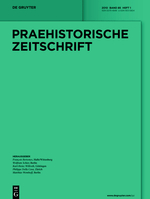
Praehistorische Zeitschrift
Connecting the Dots of Human History Through ArchaeologyPraehistorische Zeitschrift is a premier scholarly journal dedicated to the field of archaeology, published by WALTER DE GRUYTER GMBH in Germany. With a rich history dating back to 1909, the journal has evolved to encompass a wide range of topics pertaining to prehistory, offering vital insights into archaeological practices, theories, and discoveries. Recognized as a Q1 journal in both the Archaeology category of Arts and Humanities and the Social Sciences, it holds a prestigious position with Scopus rankings placing it in the top 20% of its field. Although it operates under a traditional publishing model without open access, its comprehensive articles are essential reading for researchers, professionals, and students alike who seek to deepen their understanding of prehistoric studies through rigorous academic contributions. The journal continues to publish significant research from 1993 to 2024 and beyond, making it an indispensable resource for anyone interested in the archaeological narrative of humanity.

JOURNAL OF THE POLYNESIAN SOCIETY
Exploring the Depths of Polynesian CultureJOURNAL OF THE POLYNESIAN SOCIETY, published by Polynesian Soc Inc, is a distinguished periodical that aims to disseminate high-quality research in the fields of anthropology, archaeology, and cultural studies. With an ISSN of 0032-4000 and E-ISSN 2230-5955, this journal serves as a key resource for scholars and practitioners interested in the rich historical and cultural narratives of the Polynesian region. Since its inception, the journal has published a multitude of scholarly articles, reflecting a convergence of research from 1971 to 2022, thus establishing itself as a foundational text within its domain. The journal is indexed in notable categories with a Q4 ranking in anthropology and a Q3 in both archaeology and cultural studies as of 2023, highlighting its relevant contributions to the academic community. Moreover, its impressive Scopus ranks position it within the 80th percentile for archaeology and the 67th percentile for anthropology, showcasing its dedication to scholarly excellence. Although not an open-access publication, the journal remains a vital avenue for academic discourse and exchange, making it a significant resource for researchers, professionals, and students dedicated to understanding the diverse cultures of the Pacific Islands.
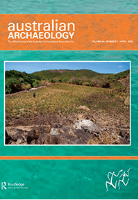
AUSTRALIAN ARCHAEOLOGY
Pioneering Research in the Heart of Archaeology.AUSTRAILIAN ARCHAEOLOGY, published by Taylor & Francis Ltd, is a leading academic journal dedicated to the field of archaeology. With a strong reputation as evidenced by its Q1 ranking in both the Arts and Humanities and Social Sciences categories, this journal fosters the growth and dissemination of pioneering research from diverse archaeological contexts. The journal has been a vital resource for scholars and practitioners since its convergence in 2002, supporting the collective advancement of knowledge in the archaeological discipline. By offering a platform for rigorous analysis and critical discussions, AUSTRAILIAN ARCHAEOLOGY appeals to a wide audience, from established researchers to students beginning their journey in archaeology. Although it is not an Open Access journal, the insights provided are invaluable for enhancing understanding and appreciation of Australia’s rich archaeological heritage. With a Scopus ranking that places it among the top contenders in its field, this journal continues to contribute significantly to outstanding archaeological scholarship and professional practice.

Lithic Technology
Pioneering Research in Stone Tool AnalysisLithic Technology is a premier international journal published by Routledge Journals, Taylor & Francis Ltd, dedicated to advancing the field of lithic studies in archaeology and anthropology. Established in 1977, this prestigious journal has established itself at the forefront of research concerning stone tool technology, providing a vital forum for scholars to share groundbreaking findings and methodologies. With an impressive Q1 ranking in both Archaeology and Anthropology, and indexed within the 91st percentile in its respective categories by Scopus, Lithic Technology is recognized for its significant contributions to the understanding of human prehistory and material culture. The journal features a diverse array of articles, from theoretical approaches to practical case studies, ensuring relevance to contemporary archaeological discourse. Though not an open-access publication, its meticulous peer-review process guarantees the highest quality of scholarship, making it an indispensable resource for researchers, professionals, and students eager to expand their knowledge in the rigors of lithic analysis.
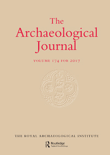
Archaeological Journal
Advancing Knowledge, Preserving Our PastArchaeological Journal, published by Taylor & Francis Ltd, stands as a leading voice in the field of archaeology, with a remarkable distinction in the Q1 category for both arts and humanities as well as conservation, underscoring its critical role in advancing scholarly dialogue and research. With an ISSN of 0066-5983 and E-ISSN of 2373-2288, this journal provides a platform for innovative research from 1977, now offering insights up to 2024. The United Kingdom-based journal is highly regarded, being within the top 81st percentile in archaeology and conservation according to Scopus rankings. Essential for researchers, professionals, and students, the journal's content spans rigorous archaeological studies, theoretical advancements, and discussions on conservation practices, ultimately aimed at fostering a deeper understanding of humanity's past. Notably, with no open access option, it maintains a traditional publishing approach, thereby ensuring curated and high-quality contributions to the academic community.
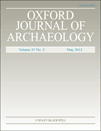
Oxford Journal of Archaeology
Uncovering the Past, Shaping the FutureOxford Journal of Archaeology is a prestigious peer-reviewed journal published by WILEY, dedicated to advancing the field of archaeology through innovative research and insightful discourse. Established in 1982, this journal has become a vital resource, showcasing high-impact studies that resonate within the arts and humanities, as well as interdisciplinary fields such as geography and planning. With an impressive Q1 ranking in both Archaeology and Arts & Humanities categories, and a Q2 ranking in Geography, Planning, and Development, the journal consistently maintains its reputation for excellence—evidenced by its ranking in the 81st percentile within the Scopus Arts and Humanities Archaeology category. The Oxford Journal of Archaeology not only provides scholars, professionals, and students with access to cutting-edge archaeological research but also encourages collaboration and dialogue among a diverse academic community. Although the journal does not currently offer Open Access, it remains a crucial platform for those seeking to expand their knowledge and impact in this dynamic field.

Kratkie Soobshcheniya Instituta Arkheologii
Pioneering Insights in the HumanitiesKratkie Soobshcheniya Instituta Arkheologii is a prestigious academic journal published by IZDATELSTVO NAUKA, specializing in the fields of archaeology and history. With an ISSN of 0130-2620, this journal has established itself as a vital resource for scholars, researchers, and students engaged in the humanities, particularly within the Russian Federation. Recognized for its high-quality contributions, it has achieved a remarkable Q1 ranking in both Archaeology and History for the year 2023, demonstrating its significant impact and relevance in these disciplines. Although it does not provide open access, the journal's robust positioning in Scopus — ranking #634 in History and #208 in Archaeology — further attests to its scholarly authority and the insightful research it disseminates. The journal covers a comprehensive range of topics, facilitating a deeper understanding of archaeological practices and historical methodologies, thereby fostering academic dialogue and knowledge advancement from 2018 through 2024. Addressing an international audience of professionals and students alike, Kratkie Soobshcheniya stands as a cornerstone for innovative research in archaeology and history.

Azania-Archaeological Research in Africa
Bridging the Past and Present of African Archaeology.Azania-Archaeological Research in Africa, published by Routledge Journals, Taylor & Francis Ltd, stands as a premier academic resource in the field of archaeology, specifically focusing on African archaeological research. With a remarkable tradition dating back to 1966, the journal spans over half a century of rigorous scholarship, aiming to enrich our understanding of Africa's diverse cultural and historical narratives. Currently indexed in the prestigious Q1 category for both Archaeology and Arts and Humanities, it ranks impressively in the Scopus database, placing within the top 12% of journals in its field. This commitment to excellence facilitates the dissemination of innovative and insightful research, catering to a broad audience of researchers, professionals, and students alike. While the journal is not open access, its impactful contributions continue to shape contemporary archaeological discourse, making it an essential resource for anyone passionate about the study of Africa's archaeological heritage.

California Archaeology
Pioneering Research in California's Archaeological NarrativeCalifornia Archaeology is a premier academic journal dedicated to the multifaceted study of archaeology within the context of California's rich historical and cultural landscape. Published by Routledge Journals, Taylor & Francis Ltd, this journal conveys cutting-edge research from 2009 to 2024 and is recognized for its impact in the field, with a commendable Q2 ranking in both archaeology and arts and humanities as of 2023. Scholars and practitioners are encouraged to disseminate their findings and insights through this journal, contributing to a deeper understanding of archaeological practices and interpretations in California. With access options designed to enhance the visibility of research, California Archaeology serves as an essential resource for professionals, students, and researchers devoted to advancing knowledge in archaeology, making it a cornerstone of academic discourse in the discipline.